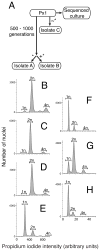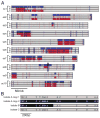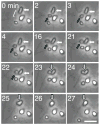Evidence for sex and recombination in the choanoflagellate Salpingoeca rosetta
- PMID: 24139741
- PMCID: PMC3909816
- DOI: 10.1016/j.cub.2013.08.061
Evidence for sex and recombination in the choanoflagellate Salpingoeca rosetta
Abstract
Nearly all animals reproduce sexually through the production and fusion of sperm and egg cells, yet little is known about the ancestry of animal sexual reproduction. Moreover, the sexual cycle of the closest living relatives of animals, the choanoflagellates, remains completely unknown. The choanoflagellate Monosiga brevicollis possesses a "meiotic toolkit" of genes, but the lack of polymorphisms detected during genome sequencing precluded inferences about its ploidy or sexual cycle. Here, we report that a related choanoflagellate, Salpingoeca rosetta, has a sexual life cycle and transitions between haploid and diploid states. Haploid cultures of S. rosetta became diploid in response to nutrient limitation. This ploidy shift coincided with anisogamous mating, during which small flagellated cells fused with larger flagellated cells. Distributions of polymorphisms in laboratory strains of S. rosetta provided independent evidence of historical recombination and mating. The ability of S. rosetta to produce morphologically differentiated gametes and to engage in sexual reproduction has implications for both reconstructing the evolution of sex in the progenitors of animals and establishing classical genetics in choanoflagellates.
Copyright © 2013 Elsevier Ltd. All rights reserved.
Figures



Comment in
-
Evolution of sex: mating rituals of a pre-metazoan.Curr Biol. 2013 Nov 18;23(22):R1006-R1008. doi: 10.1016/j.cub.2013.10.009. Curr Biol. 2013. PMID: 24262825
Similar articles
-
Transfection of choanoflagellates illuminates their cell biology and the ancestry of animal septins.Mol Biol Cell. 2018 Dec 1;29(25):3026-3038. doi: 10.1091/mbc.E18-08-0514. Epub 2018 Oct 3. Mol Biol Cell. 2018. PMID: 30281390 Free PMC article.
-
Choanoflagellate models - Monosiga brevicollis and Salpingoeca rosetta.Curr Opin Genet Dev. 2016 Aug;39:42-47. doi: 10.1016/j.gde.2016.05.016. Epub 2016 Jun 17. Curr Opin Genet Dev. 2016. PMID: 27318693 Review.
-
Genome editing enables reverse genetics of multicellular development in the choanoflagellate Salpingoeca rosetta.Elife. 2020 Jun 4;9:e56193. doi: 10.7554/eLife.56193. Elife. 2020. PMID: 32496191 Free PMC article.
-
Evolution of sex: mating rituals of a pre-metazoan.Curr Biol. 2013 Nov 18;23(22):R1006-R1008. doi: 10.1016/j.cub.2013.10.009. Curr Biol. 2013. PMID: 24262825
-
[Mating types, sexual reproduction and ploidy in fungi: effects on virulence].Mikrobiyol Bul. 2009 Jul;43(3):507-13. Mikrobiyol Bul. 2009. PMID: 19795629 Review. Turkish.
Cited by
-
Transfection of choanoflagellates illuminates their cell biology and the ancestry of animal septins.Mol Biol Cell. 2018 Dec 1;29(25):3026-3038. doi: 10.1091/mbc.E18-08-0514. Epub 2018 Oct 3. Mol Biol Cell. 2018. PMID: 30281390 Free PMC article.
-
What is it like to be a choanoflagellate? Sensation, processing and behavior in the closest unicellular relatives of animals.Anim Cogn. 2023 Nov;26(6):1767-1782. doi: 10.1007/s10071-023-01776-z. Epub 2023 Apr 17. Anim Cogn. 2023. PMID: 37067637 Free PMC article. Review.
-
Actomyosin organelle functions of SPIRE actin nucleators precede animal evolution.Commun Biol. 2024 Jul 8;7(1):832. doi: 10.1038/s42003-024-06458-1. Commun Biol. 2024. PMID: 38977899 Free PMC article.
-
A stress-responsive p38 signaling axis in choanoflagellates.RSC Chem Biol. 2025 Apr 1;6(6):891-904. doi: 10.1039/d4cb00122b. eCollection 2025 Jun 4. RSC Chem Biol. 2025. PMID: 40226336 Free PMC article.
-
A red algal polysaccharide influences the multicellular development of the choanoflagellate Salpingoeca rosetta.bioRxiv [Preprint]. 2024 May 15:2024.05.14.594265. doi: 10.1101/2024.05.14.594265. bioRxiv. 2024. Update in: Curr Biol. 2025 Aug 4;35(15):3767-3776.e4. doi: 10.1016/j.cub.2025.06.059. PMID: 38798503 Free PMC article. Updated. Preprint.
References
-
- Carr M, Leadbeater BSC, Baldauf SL. Conserved Meiotic Genes Point to Sex in the Choanoflagellates. Journal of Eukaryotic Microbiology. 2010;57:56–62. - PubMed
Publication types
MeSH terms
Grants and funding
LinkOut - more resources
Full Text Sources
Other Literature Sources
Molecular Biology Databases

